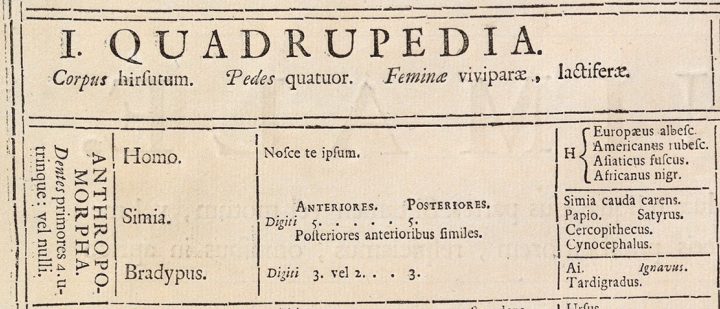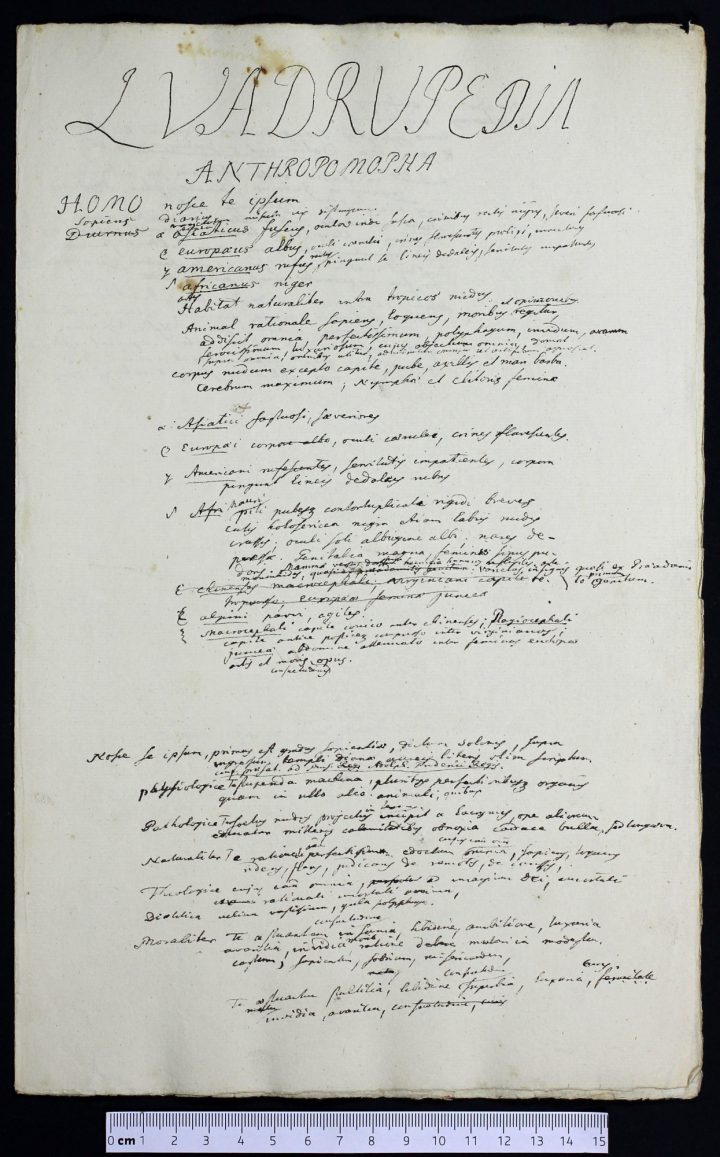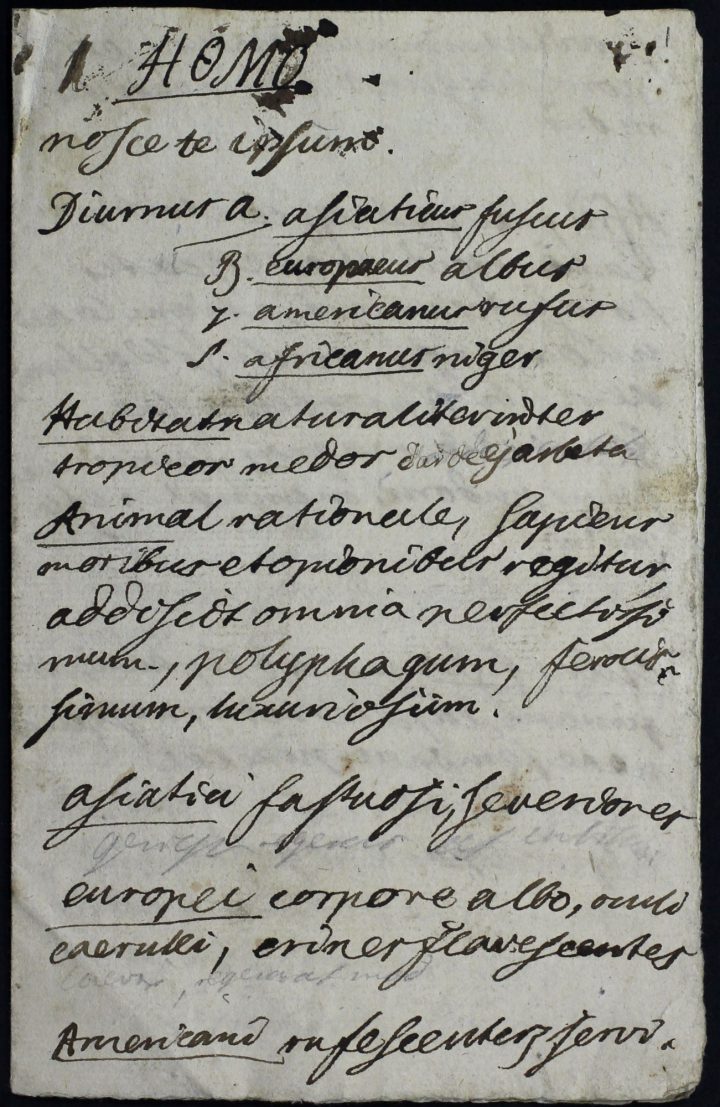Linnaeus and Race
One of the origins of scientific racism can be traced to Linnaeus’ work on the classification of man, which had devastating and far-reaching consequences for humanity.
If you wish to read our easy-read version on this subject, click here.
Video discussion:
You might be interested in watching the recording of our Day Meeting entitled 'Linnaeus, Race and Sex' which brought together researchers from different disciplines (natural sciences, evolutionary biology, philosophy, history of science and gender studies) to discuss ‘race’ and ‘sex’ in Linnaeus’ work and beyond. Click the link above to watch.
Linnaeus’ work on the classification of man forms one of the 18th-century roots of modern scientific racism. This page aims to look at Linnaeus’ works in detail, both printed and in manuscript, to trace the development of an idea which became fundamental in the history of anthropology and has had devastating and far-reaching consequences for humanity, including the dehumanisation of non-Europeans and justification of evils like slavery and indigenous genocide.
The Linnean Society intends to confront the consequences of scientific racism; one of the first steps is to look at Linnaeus’ writings, in order to address the consequences of his views on human diversity through our education, outreach, and research activities.
As fundamental as Linnaeus’ classification of man has been, surprisingly few studies have looked in-depth at the writings of Linnaeus to go beyond his main work on the subject: the 10th edition of Systema naturae. Gunnar Broberg’s 1975 book on Linnaeus’ Homo sapiens, was one such study, but published in Swedish and never translated into English; Staffan Müller-Wille has in the last few years published articles which endeavour to address the role Linnaeus’ works played as the foundation for the modern concept of race. This page is particularly indebted to the latter’s work.
Man as an animal
Linnaeus first published his major classificatory work Systema naturae in 1735, at the age of 28. Systema naturae provided a classification of the (then) three kingdoms of nature: mineral, vegetable and animal.

The kingdom of animals ('Regnum Animale') in Linnaeus' first edition of Systema naturae, 1735
Linnaeus was the first naturalist to include man within the animal kingdom. In 1735, the class into which Linnaeus inserted man was called Quadrupeds, and the order, Anthropomorpha. These names Linnaeus would change to Mammals and Primates later on in his career. The order of Anthropomorpha contained the genera Homo (humans), Simia (apes) and Bradypus (sloths).

The order of Quadrupeds in Systema naturae, 1735
The choice to include humans within animals and quadrupeds was not welcomed by everyone. In a letter dated 1 September 1735, the Dutch naturalist Gronovius told Linnaeus that he disagreed with his decision to include humans under Quadrupeds ‘For although Man ranks first among the animals, he should in fact be considered to excel all other living beings which were created by God to Man’s delight and benefit.’[1] In another letter to the St Petersburg naturalist Johann Georg Gmelin some 12 years after the first publication of Systema naturae, Linnaeus mentioned the persistent irritation expressed by scholars, yet he challenged Gmelin and the rest of the world to name a generic difference between man and ape, based on the principles of natural history.[2]
Having placed humans within the animal kingdom, Linnaeus distinguished them from other animals in the same order of Anthropomorpha by the ability to ‘know thyself’ (‘Nosce te ipsum’). This would lead Linnaeus to attribute the specific epithet sapiens to the genus Homo when he began to use his binomial nomenclature in the 1750s. He then proceeded to classify humans further, as he did with other organisms.
Humans classified
Subspecies or varieties?
Systema naturae was edited 12 times in Linnaeus’ life. As each edition was amended, corrected and augmented, Systema naturae grew in scope and content. For the first 9 editions (1735-1756), Linnaeus’ classification of man remained stable, with the human species divided into four types, or “varieties”, as he called them in Latin.

Quadrupeds in Systema naturae 2nd edition, 1740
Europaeus albus: European white
Americanus rubescens: American reddish
Asiaticus fuscus: Asian tawny
Africanus niger: African black
The word that Linnaeus uses to denote the taxon below the species, is ‘varieties of man’: ‘Homo variat' (literally 'Man varies'). As far as is known, Linnaeus never used the word race, in reference to humans or any other organisms. The term ‘variety’ is significant: while ‘subspecies’ would distinguish stable types, ‘varieties’ do not.
In a botanical tract entitled Critica botanica (1737), Linnaeus further expressed views about the human species and its variations, which for him were not stable and varied according to climate and environment:
[God] created one human, as the Holy Scripture teaches; but if the slightest trait [difference] was sufficient, there would easily stick out thousands of different species of man: they display, namely, white, red, black and grey hair; white, rosy, tawny and black faces; straight, stubby, crooked, flattened, and aquiline noses; among them we find giants and pygmies, fat and skinny people, erect, humpy, brittle, and lame people etc. etc. But who with a sane mind would be so frivolous as to call these distinct species? [3]
Geographical variations
Linnaeus’ division into four varieties of man corresponded to the then known four continents of the world: Europe, America, Asia and Africa. This division according to the four corners of the world is one that came back in a variety of ways in Linnaeus’ writings on plants and commodities (coffee, tea, beer and chocolate also represented the four continents, for instance).
This emphasis on geography has been stressed by recent scholars: Müller-Wille has argued that Linnaeus did not present ‘human races as distinct types. In fact, Linnaeus shared contemporary views that skin-color – the chief criterion of distinction employed in the Systema naturae – was largely a product of climate, and hence as variable as other “accidental” bodily characteristics of humans, such as stature or weight’.[4]
Similarly, Ezra Tawil writes ‘If we are careful to situate Linnaean thought in the context of eighteenth-century theories of difference, we immediately recognise that Linnaeus’ four primary taxonomic categories (…) are not functions of biology or morphology, but rather of geography.’[5]
Further classification
Sometime in the 1750s, Linnaeus started revising his classification of humans, to add physical and moral attributes to geography and skin colour. Further analysis of Linnaeus’ works, both printed and manuscripts (including his correspondence) should be undertaken to understand why he took the step of deepening the classification of humans, in ways which would have such unfortunate long lasting consequences.
For instance, a manuscript draft entitled ‘Anthropomorpha’, dating from between 1748 and 1758, contains numerous reworked pages of possibly lecture notes that go beyond simply stating the locality and skin colour.[6] The amendments and crossing outs indicate that this was a work in progress. The manuscript also includes extracts of other works that Linnaeus was reading on the subject, and which may have influenced some of his classification, such as Pierre Louis Maupertuis, but also older works such as Pliny.

Linnaeus' manuscript 'Anthorpomorpha' contains many iterations of the description of Homo sapiens. Here, folio 2.
The result of this expansion of the classification of man was the 1758 10th edition of Systema naturae, which became the basis for scientific racism. To the four continents and the four varieties of humans, Linnaeus added the four temperaments, or humours. According to medieval medical doctrine, which still had currency in the 18th century, the four humours were thought to be sanguine (blood), choleric (yellow bile), melancholic (black bile), and phlegmatic (phlegm). Their composition within the body was considered to determine a patient's personality and health concerns. By adding these, and other moral attributes, he departed from the purely geographic and environmental factors.
Whereas the previous editions classified man within four lines, the 10th edition devotes 5 pages to the genus Homo. Extensive footnotes cover half the page.


Homo sapiens in Systema naturae 10th edition, 1758

The four varieties have become six, and Linnaeus added notes on different lines describing the following attributes:
- Skin colour, medical temperament (corresponding to the four medieval humours), and body posture;
- Physical traits relating to hair colour and form, eye colour, and distinctive facial traits;
- Behaviour;
- Manner of clothing;
- Form of government.
Leaving aside the first variety of wild children and youngsters (Ferus) and the last variety of Monstrosus (see below the table), the resulting classification thus looks like this:
| Species | 1 | 2 | 3 | 4 | 5 |
|---|---|---|---|---|---|
| Americanus | Red, choleric and straight | Straight, black and thick hair; gaping nostrils; [freckled] face; beardless chin | Unyielding, cheerful, free | Paints himself in a maze of red lines | Governed by customary right |
| Europaeus | White, sanguine, muscular | Plenty of yellow hair; blue eyes | Light, wise, inventor | Protected by tight clothing | Governed by rites |
| Asiaticus | Sallow, melancholic, stiff | Blackish hair, dark eyes | Stern, haughty, greedy | Protected by loose garments | Governed by opinions |
| Africanus | Black, phlegmatic, lazy | Dark hair, with many twisting braids; silky skin; flat nose; swollen lips; Women [with] elongated labia; breasts lactating profusely. | Sly, sluggish, neglectful | Anoints himself with fat | Governed by choice [caprice] |
As Müller-Wille has remarked: ‘It cannot be emphasized enough how phantastic Linnaeus’s color scheme actually is, if judged in terms of the humoral doctrine: white is red (sanguine), black is white (phlegmatic), yellow is black (melancholic), and red is yellow (choleric).’[7]
The fifth variety of ‘monstrous’ humans included groups which were allegedly shaped by their environment: the Alpini, living high in the mountains, for instance, are ‘small, agile and shy’. In the ‘monstruous’ variety, Linnaeus also placed the Khoikhoi ("Hottentots" in the text) who according to him were less fertile, owing to the fact that they had only one testicle (hence the name Monorchides), and European girls with artificially constricted waists (‘Juncae puellae abdomine attenuato’).
Linnaeus continuously revised his work, and his copies of Systema naturae were interleaved so that he could insert amendments and corrections for the next edition. The entry for Homo sapiens in his copy of 1758 Systema naturae shows some of the corrections that he meant to implement in the next edition. One of the corrections which was introduced in the final, 12th edition from 1766 was the substitution of ‘cheerful’ (‘hilaris’) with ‘content’ (‘contentus’) in the description of Americanus.
Hierarchies
The initial 1735 classification of man started with Europaeus, then went on with Americanus, Asiaticus and ended with Africanus.
A manuscript of Linnaeus’ son (also called Carl Linnaeus, the Younger), consisting of notes taken when Carl the Younger was following his father’s lectures in the mid-1750s as a young boy, shows how Linnaeus was teaching the classification of man to his students. In these lecture notes, Linnaeus started his lecture with Asiaticus, followed by Europaeus, Americanus and Africanus.[8]

Lecture notes taken by Linnaeus' son, also Carl Linnaeus (the Younger) on the genus Homo.
The same order can be found in the ‘Anthropomorpha’ manuscript described earlier, indicating that Linnaeus' hierarchy, if there was one, fluctuated in the years leading up to 1758.
By the 10th edition of Systema naturae, Linnaeus switched the order in which the varieties appear yet again, and chose to place Americanus first, possibly influenced by ideas of the ‘noble savage’. One variety never varied in this hierarchy, however: Africanus consistently remained at the bottom of the list. Moreover, in all editions, Linnaeus’ description of Africanus was the longest, most detailed and physical, and also the most negative.
Races of man
Enlightenment thinkers inherited a very hierarchical view of the natural world from the Middle Ages and the Renaissance: a ‘Great chain of beings’ arranged in a series of gradients or steps, with God at the very top, man underneath, and down through animals and vegetables to inorganic minerals at the bottom. Linnaeus' taxonomic work partly upset this linear hierarchy of more or less ‘perfect’ natural beings. The alignment of races with four continents, for example, put them all on the same level as ‘natural’ varieties. But the idea of a graded scale of nature also survived in the linear arrangement of human varieties. Linnaeus’ classification of man was certainly viewed by contemporaries in a hierarchical manner, and carried on being used in such a way through the following decades. Thus Linnaeus’ hierarchy, with black people at the very bottom, associated with negative moral and physical attributes, stuck.
Linnaeus was not the only naturalist writing about the human species in the eighteenth century. In fact, he wrote comparatively less on the subject than his contemporaries, such as the Comte de Buffon and Maupertuis in France, or the German physician Johan Friedrich Blumenbach, all of whom would influence later writers such as Immanuel Kant and Charles Darwin.
What remained influential was Linnaeus’ classification. Authors after Linnaeus presented his classification of humans as a series of trinomials (three scientific names - genus, species, and subspecies), entrenching the view that Linnaeus’ varieties were really sub-species. This was the case in the English translation of Linnaeus in 1792, which probably gave rise to the idea that Linnaeus believed that human races actually constituted subspecies.[9] This highlights how ambivalent and very tentative ideas in science can become entrenched with time due to developments in wider culture.
Dr Isabelle Charmantier, Head of Collections
Posted 3 September 2020
Acknowledgement
I am extremely grateful to Dr Staffan Müller-Wille for advice and reading through a first draft of this text.
Notes
[1] Johan Frederik Gronovius to Carl Linnaeus, 1 September 1735, see Uppsala University Library for abstract in English.
[2] Carl Linnaeus to Johann Georg Gmelin, 25 February 1747, see Uppsala University Library for full record.
[3] Carl Linnaeus, Critica botanica (Leiden, 1737), quoted in Staffan Müller-Wille, ‘Linnaeus and the four corners of the world’, in The Cultural Politics of Blood, 1500–1900, edited by Kimberly Anne Coles et al (Basingstoke, 2015), p. 9 of online pdf.
[4] Müller-Wille, ‘Linnaeus and the Four Corners of the World’, p. 4 of online pdf.
[5] Ezra Tawil, The Making of Racial Sentiment (Cambridge, 2006), 43.
[6] Carl Linnaeus, ‘Anthropomorpha’ (1748-1758), LM/LP/ZOO/2/1/1/1, f. 3.
[7] Müller-Wille, ‘Linnaeus and the four corners of the world’, p. 22 of online pdf.
[8] Carl Linnaeus the Younger, ‘Homo’ (pre-1758), LM/LF/ZOO/1/1/1.
[9] Carl Linnaeus, The Animal Kingdom, or Zoological System, edited by Johann Friedrich Gmelin, translated by Robert Kerr (London and Edinburgh: A. Strahan, T. Cadell, and W. Creech, 1792), p. 45.
Further Reading
Gunnar Broberg, Homo sapiens L.: Studier i Carl von Linnés naturuppfattning och människolära (Uppsala: Almquist & Wiksell, 1975).
Müller-Wille, Staffan, ‘Race and History: Comments from an Epistemological Point of View’, Science, Technology, & Human Values 2014: 39(4), 597–606. https://www.ncbi.nlm.nih.gov/pmc/articles/PMC4326670/
Skuncke, Marie-Christine, ‘Linnaeus: an 18th century background’, The Linnaean Legacy: Three Centuries after his Birth (London, 2008), pp. 19-26. https://ca1-tls.edcdn.com/documents/Special-Issue-8-The-Linneaen-Legacy.pdf?mtime=2016021306073
